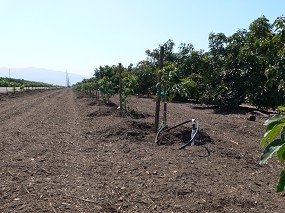- Author: Ben Faber, University of California Cooperative Extension
- Author: Michael Spiers, HortResearch, Ruakura, New Zealand
Biological control of Phytophthora cinnamomi in avocado through the use of mulches was identified by an Australian grower and later described as the "Ashburner Method" by Broadbent and Baker. The technique uses large amounts of organic matter as a mulch along with a source of calcium. Control of avocado root rot in the Ashburner method was attributed to the presence of Pseudomonas bacteria and Actinomycetes. Multiple antagonists are more likely the cause of biological control, since no single organism has been found to be consistently associated with soils suppressive to P. cinnamomi.
The use of organic mulches has multiple effects, such as altered soil nutrient and water status and improved physical structure. Any improvements in plant status resulting from improvements in the growing environment can improve plant health. The effect of organic amendments on soil physical and chemical properties can vary considerably depending on soil texture and the environment. One of the most consistent effects of organic amendments is an increase in biological activity. Increases in organic substrate lead to increased fungal and bacterial populations. In numerous cases, this increase in biomass has been associated with disease suppression. This biological control can be ascribed to several mechanisms: competition, antibiosis, parasitism, predation and induced resistance in the plant.
The microbial biomass is responsible for release of enzyme products and polysaccharides in soils. The microbially-produced enzymes cellulase and glucanase have been demonstrated to have a significant effect on Phytophthora populations. This mechanism of antibiosis is possible because the microbes are releasing these enzymes to solubilize organic matter. Unlike other fungi, Phytophthora have cell walls that are comprised of cellulose and in the process of decomposing organic matter with enzymes, an environment is created that is also hostile to the pathogen.
In order to see if there might be potential differences in organic materials being better at combating avocado root rot, a little field trial was established with 23 different types of materials. The mulch materials were obtained from nearby hedges and chipped or obtained from commercial sources of mulch. Some of these materials would be difficult to get in large amounts, such as manuka (Leptospermum scoparium), but others are commercially available chipped greenwaste. The materials were then spread on the ground to a depth of five inches, in separate plots that were 36 X 36 inch squares. Decomposition was measured over a two year period and then cellulase was measured in the mulch, at the soil / mulch interface and at a two inch depth in the soil at the end of 2 years.
Since cellulase production is part of the decomposition process, the rate of decomposition should be a partial indicator of the amount of cellulase present. After a mulch application there is generally settling due to rainfall-caused compaction, but much of the decline by the second year is due exclusively to decomposition. The more recalcitrant materials, such as bark, wood chips and sawdust have barely lost half their depth after two years, while others such as shredded eucalyptus, manuka, avocado and willow are less than 20% of their initial depth. Much of the shredded/chipped material, such as eucalyptus had a significant fraction of leaves in the mulch. The wool disappeared a little after one year. The greenwaste + chicken manure compost is nearly the same depth as the wood chips, since it is a material that had gone through a decomposition process prior to its application and much of the easily digestible materials had already been decomposed.
The rate of decomposition has some bearing on the rate of cellulase production. Eucalyptus and manuka had the two greatest rates of decomposition and show the highest levels of cellulase production. The cellulase levels were consistent with all the different mulch materials. Using decomposition rate alone is not a complete indicator of cellulase production since, poplar, willow and avocado had high rates of decomposition, but their cellulase rates were half those of manuka and eucalyptus.
It is clear that the cellulase effect is limited to the layer of mulch and not to depth within the soil. There is some effect at the soil surface, but at 5 cm (2 inches) cellulase activity drops to background levels. There is earthworm activity at the test sites and one idea was that earthworm incorporation of organic matter would move the cellulase production into the soil. Maybe with further time this would occur. As it is, when mulches are applied to avocado, the roots tend to proliferate in the mulch, out of the soil where the cellulase activity is the least.
Something to keep in mind is that we do not know what levels of cellulase are necessary to control the root rot fungus. It may be that levels seen with pine bark are more than adequate. Also we have measured cellulase production at only one time in a two-year period and it is quite likely that this is not the best snapshot of what is happening before and after. A further reminder is that cellulase is only one of the many byproducts associated with decomposition and many of the antagonistic properties that are associated with the microbial biomass are not being measured in this trial. Having developed this screening procedure what needs to be done next is to take high, medium and low cellulase producing mulches and challenge the fungus to verify that this is a good way to evaluate mulches.




